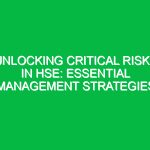Welcome, team! Today, we are going to delve into a crucial aspect of our daily operations: Communicating Issues within the Health, Safety, and Environment (HSE) domain. Effective communication plays a vital role in maintaining a safe and healthy work environment for all of us. Let’s explore how mastering this skill can significantly impact our safety and well-being.
The Importance of Communicating Issues
Clear and concise communication is the cornerstone of a successful safety program. When we effectively communicate issues related to health, safety, and the environment, we can prevent accidents, mitigate risks, and ensure everyone’s well-being. Whether it’s reporting hazards, discussing safety procedures, or conveying emergency protocols, communication is key to maintaining a safe work environment.
Key Aspects of Communicating Issues
When it comes to communicating issues within the HSE domain, there are several key aspects to consider:
- Clarity: Ensure that your messages are clear and easy to understand.
- Timeliness: Report issues promptly to prevent any potential hazards from escalating.
- Accuracy: Provide accurate information to facilitate swift and appropriate action.
- Feedback: Encourage open communication and feedback to address any concerns or suggestions.
Potential Hazards and Risks
Failure to communicate effectively can lead to serious consequences, including accidents, injuries, or environmental damage. By being vigilant in communicating issues, we can identify and address potential hazards before they pose a threat to our safety.
Best Practices for Communicating Issues
Here are some best practices to help you master effective communication within the HSE domain:
- Use clear and concise language: Avoid jargon or technical terms that may be confusing to others.
- Provide context: Explain the relevance and importance of the issue being communicated.
- Seek clarification: If you are unsure about something, don’t hesitate to ask for clarification.
- Follow up: Ensure that all communication is followed up with necessary actions or updates.
Real-Life Examples
Let’s consider a hypothetical scenario: If you notice a spill in the work area that could pose a slip hazard, how would you communicate this issue to your team members? By promptly informing them and taking appropriate action, you can prevent accidents and ensure a safe working environment for everyone.
Regulations and Standards
It’s essential to adhere to all relevant regulations, standards, and company policies when communicating issues within the HSE domain. Compliance not only ensures our safety but also fulfills our legal obligations to maintain a secure work environment.
Conclusion
As we conclude this Toolbox Talk on mastering effective communication for health, safety, and environment issues, I urge each of you to prioritize clear and timely communication in your daily work. By effectively communicating issues, we can prevent accidents, promote safety, and create a positive work environment for all. Thank you for your attention and commitment to safety. Stay safe!


